| |||||||
 |
| Search this Thread |  146,929 views |
| | #1 |
| Team-BHP Support  | Offroading with the Jeep Compass Trailhawk This report has been jointly compiled with Blackwasp. Thanks to him for the expert observations! When the Jeep Compass was launched in 2017, the limelight was mainly on the on-road aspect of this mid-size SUV. Like most premium SUVs, only the highest variant had AWD. This didnít help the Compass lay claim to Jeepís legendary offroad legacy in any sense. But there were whispers of a true blue offroad variant that would be launched at a later date. The date arrived almost 2 years later. And that variant is called the Trailhawk, a Trail Ratedģ 4x4 vehicle:  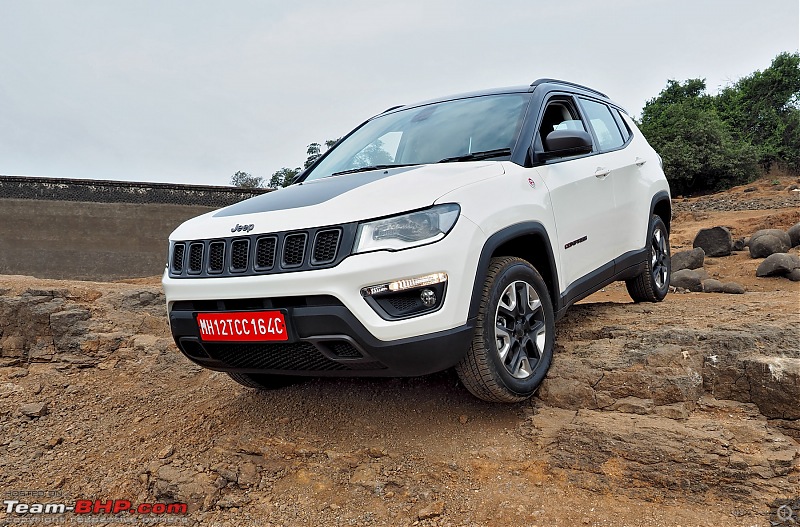 According to the Jeep website, a Trail Ratedģ badge is not given, itís earned. Every Trail Rated 4x4 Jeep vehicle has succeeded against a series of grueling tests in five categories: Traction, Water Fording, Maneuverability, Articulation and Ground Clearance. To emphasize this point, Jeep India held a special offroad media drive in Lonavala: 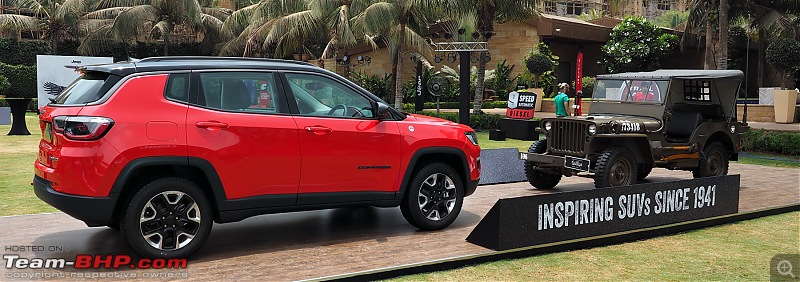 The original WWII Jeep manufactured in 1941 by Willys-Overland:   In order to prove the Trail Rated badge of the Trailhawk, Jeep India brought in a 4WD adventure company from the USA, namely Jeep Jamboree USA. JJUSA has been conducting Jeep offroad events since 1954 and it is probably the very first 4WD adventure company in the world:  |
| |  (43)
Thanks (43)
Thanks
 |
| The following 43 BHPians Thank Samurai for this useful post: | 2himanshu, arun_josie, ast.ggn, BlackPearl, carrot_eater, chinmaypillay, ChiragM, Contrapunto, dailydriver, dhanushs, Dr.AD, DrANTO, Flyer, GTO, gunin, haisaikat, InControl, Jaggu, jithin23, Joxster, karan561, Keynote, N33raj, PapaBravo, paragsachania, RavenAvi, samaspire, Samba, Sheel, Simat, somspaple, sridhar-v, SS-Traveller, suhaas307, The Rationalist, theexperthand, The_Outsider!, timuseravan, Turbanator, uday.ere, Varun_HexaGuy, vb-saan, VTec_KickedInYo |
| |
| | #2 | |
| Team-BHP Support  | Before we go into the trail experience, let’s look at why the Trailhawk is considered an offroad specialist in the Jeep Compass line-up. Ground Clearance: The ground clearance of the regular Compass is 155 mm (laden) and 178 mm (unladen). According to the powerpoint presentation they gave, the Trailhawk has a 30 mm suspension lift. Superior Approach / Breakover / Departure angle: There is a huge improvement in the approach (26.5), breakover (21.2) and departure (31.6) angles. Skid Plates: Trailhawk has high-grade, heavy-duty steel and high-quality black e-coated skid plates covering the cooling module, engine, transmission oil pans, front suspension and fuel tanks. Hill Descent Control: This feature activates front and rear brakes while going down a slope, ensuring a very controlled descent. However, this feature won’t activate unless the angle is steep enough. Improved water wading depth: The Trailhawk’s water wading depth is 483 mm, which is much improved compared to the 330 mm of the other variants. Torque: The Trailhawk's axle ratio is 4.33, while it is 3.73 for the Limited 4x4. The first gear ratio is 4.7 for both 4x4 variants. That makes the maximum crawl ratios 20.35 and 17.53 for the Trailhawk and the Limited 4x4 respectively. The Trailhawk also claims to have 4WD Low, but in a very non-traditional way. Usually, 4WD Low refers to additional torque multiplication provided by the transfer case gear. That is not the implementation you will find on the Trailhawk. In the Jeep Compass Limited 4x4, the crawl ratio of 17.53 is achieved by multiplying the axle ratio of 3.73 with the first gear ratio of 4.7. Since the Limited 4x4 came only with a manual transmission, the first gear was easily accessible. This variant has only 4WD High, with a crawl ratio starting at 17.53, and only going lower at higher gears. In the Trailhawk, the only available transmission is the 9-speed automatic. However, the car starts in 2nd gear (ratio 2.84) when in automatic mode. That is considered as 4WD High, with a crawl ratio of 12.29 achieved by multiplying the axle ratio of 4.33 with the second gear ratio of 2.84. The first gear is engaged only when the Trailhawk is put into 4WD Low, to give the crawl ratio of 20.35. In other words, the 4WD High of Limited 4x4 has a much better crawl ratio than 4WD High of Trailhawk. The Trailhawk 4WD Low has just a 16% better crawl ratio than the Limited 4x4 variant. That is not a great improvement. When compared to other 4WD vehicles equipped with a transfer case, it has only half as much a crawl ratio. For example, the Mahindra Thar has a maximum crawl ratio of 40.3 in 4WD Low. Even if you consider the Trailhawk's 350 Nm of torque vs the Thar’s 247 Nm, by having half the crawl ratio of the Thar, the Trailhawk appears to be a weaker offroader on paper. The 4x4 system of the Trailhawk is exactly the same as the Limited 4x4, but with an additional mode called Rock. The Rock mode operates in the new 4WD Low setting since it requires the maximum crawl ratio available. If the driver switches to Tiptronic shifting in 4WD mode, he/she can move between the 1st and 2nd gears only:  The rest of the 4x4 modes and their behaviour is explained in our Jeep Compass official review. That review had concluded as follows: Quote:
Do note that the crawl ratio was not one of the concerns raised in our earlier review. This is one question that is frequently raised by offroaders experienced in mechanical offroad vehicles like the Thar. How can newer offroad vehicles with offroad electronics, but with half the crawl ratio, match up to mechanical offroad vehicles (without diff locks) on the trail? The answer is very well. In fact, on slippery trails, the Trailhawk can outperform the traditional offroaders if driver skills are similar. Let’s see how that is made possible. Last edited by Samurai : 23rd August 2019 at 12:35. | |
| |  (41)
Thanks (41)
Thanks
 |
| The following 41 BHPians Thank Samurai for this useful post: | 2himanshu, arun_josie, Axe77, bj96, BlackPearl, blackwasp, carrot_eater, ChiragM, cool_dube, dailydriver, dhanushs, di1in, djay434, Dr.AD, DrANTO, Flyer, GTO, Jaggu, jithin23, Joxster, Keynote, megazoid, N33raj, PapaBravo, paragsachania, petroguzzler, RavenAvi, samaspire, Samba, Sheel, Simat, somspaple, suhaas307, sups, theexperthand, Thermodynamics, Turbanator, uday.ere, unknownartist01, Varun_HexaGuy, vb-saan |
| | #3 |
| Team-BHP Support  | Traction happens to be the most important aspect of offroad driving. That is the sole reason why offroad vehicles have 4-wheel drive instead of 2-wheel drive. In a two-wheel drive vehicle with an open differential, if one tyre loses traction, that tyre starts spinning and the other tyre will stop turning. This is because an open differential sends the same amount of torque to both wheels. The tyre without traction demands just enough torque to spin the wheel, and that is the amount of torque sent to both the drive axles. That amount is not enough to move the tyre with traction, so it just stops. This puts very little load on the engine, which generates just enough torque to spin the tractionless wheel, and nothing more. To put this in numbers: let’s say 10 Nm of torque is required to overcome the traction of one of the tyres, then the engine will generate 20 Nm of torque, and the differential will send 10 Nm to each drive axle. It doesn’t matter if the engine is capable of generating 100 Nm or 200 Nm or 400 Nm of torque. The torque generated is entirely dependent on the load, which in turn, depends on the traction. The maximum torque generated is also limited by the engine capacity, that goes without saying. At maximum load (say steep uphill) and with perfect traction, we can calculate the force put out by the Trailhawk and the Thar to the road surface. We are picking the Thar for comparison since it is the only other offroader in the market that also claims the legacy of the WWII Jeep.  : : In other words, if the traction is good, the Mahindra Thar has a clear edge over the Trailhawk. However, offroading is mostly about going into trails with bad traction. When the tyres start losing traction, they start spinning, which reduces the load, and all the above calculations turn meaningless. Now the advantage goes to the vehicle that can make best use of the available traction to any of the wheels. The Mahindra Thar has open front and rear differentials, but the front and rear propeller shaft are locked together in 4WD mode. Therefore, if one tyre in the front loses traction, the front propeller will deliver very little torque. Instead, all of the torque will be delivered to the rear propeller, provided both the rear tyres retain traction. Similarly, if one of the rear tyres loses traction, all the torque will be delivered to the front propeller. That means, if any one tyre loses traction, Thar turns into a two-wheel drive vehicle. If one tyre in both the front and the rear lose traction at the same time, then the vehicle is a sitting duck. This happens often enough on offroad trails. Drivers often overcome this by using momentum, or putting weight on the slipping side, etc. Therefore, driver skill becomes very important in mechanical offroad vehicles. The Trailhawk too has open front and rear differentials, and their propeller shafts are effectively locked together in 4WD lock mode. But it has more. It has sensors at each wheel to detect whether the wheel is turning faster than the car is moving. It also has computer-controlled individual disc brakes on each wheel. When a tyre loses traction and starts to spin, it is detected instantly by the sensor. This enables the computer to apply brakes to that wheel so that speed matches the other wheel with traction. The lack of traction is compensated by the brake resistance. So the load will increase and torque will continue to flow. That means if any one tyre loses traction, the Trailhawk turns into a three-wheel drive vehicle, not two-wheel drive like the Thar. If one tyre in both the front and the rear lose traction at the same time, then the Trailhawk continues to send torque to the remaining two wheels with traction. It will also send an equal amount of torque to the tractionless tyre that is under brake resistance, which is dissipated as heat. A Thar would be immobile at this point, but the Trailhawk keeps moving. Furthermore, if 3 tyres lose traction, all of them will encounter brake resistance, ensuring that the only tyre with traction will get 1/4th of the torque generated by the engine. None of the above requires any driver input or skill. This is the first clear advantage the Trailhawk's electronics have over mechanical offroaders. When an offroad vehicle travels on slippery terrain, the traction offered to each tyre keeps changing continuously. In a mechanical offroader like Thar, the driver has to continuously watch, anticipate, avoid, compensate or recover from situations where vehicles can get stuck. On the other hand, the Trailhawk's wheel sensors will be continuously watching for loss of traction in all four wheels. When loss of traction is detected, it will apply brake resistance instantly and individually to compensate, and release the brakes instantly when the traction is restored. Since the traction status of all the wheels is available instantly, the computer can use complicated algorithms to compensate for it. For a given terrain setting (Auto, Snow, Sand, Mud & Rock), the Trailhawk has custom algorithms to compensate by using a combination of braking and gearing. Even the most vigilant driver will not be able to match this electromechanical control system. This is the second clear advantage the Trailhawk's electronics have over mechanical offroaders. Just like how computers can beat any human at chess, electronics (and software) now have a clear advantage over human drivers in salvaging most traction on slippery terrain. And these algorithms and electronics will continuously get better with every iteration. The torque and the crawl ratio matter only if the vehicle can hold on to some traction. PS: As corrected pointed out by BHPian nishkamm, the above behavior applies to Thar models until Aug-2015. After that Thar came with Mechanical Locking Rear Differential or MLD on rear differential. When the difference between wheel speed exceed 100rpm or 1.6rps at the rear differential, it sends all the torque to the wheel with traction. Unlike Trailhawk, it doesn't waste 1/2 the torque for braking. This nullifies the Trailhawk advantage mentioned in the above paragraphs, at least over MLD equipped Thar. Last edited by Samurai : 23rd August 2019 at 12:04. |
| |  (51)
Thanks (51)
Thanks
 |
| The following 51 BHPians Thank Samurai for this useful post: | 2himanshu, Arjun Reddy, arun_josie, arvind71181, bj96, BlackPearl, blackwasp, carrot_eater, ChiragM, cool_dube, Crazy_cars_guy, dailydriver, dhanushs, diliprayar, Dr.AD, DrANTO, Flyer, GoBlue, GTO, Hayek, Jaggu, jithin23, Joxster, karan561, Keynote, Machalu, megazoid, N33raj, nishkamm, paragsachania, petroguzzler, PM - B, puneetakhouri, RavenAvi, rtdp, ruzbehxyz, sagarpadaki, Samba, shipnil, Simat, somspaple, SS-Traveller, sub.g84, theexperthand, Turbanator, uday.ere, unknownartist01, vb-saan, VTec_KickedInYo, warrioraks, WhiteKnight |
| | #4 |
| Team-BHP Support  | The Trail Drive The offroad trail was divided into 5 zones to demonstrate all the strengths of the Trailhawk: 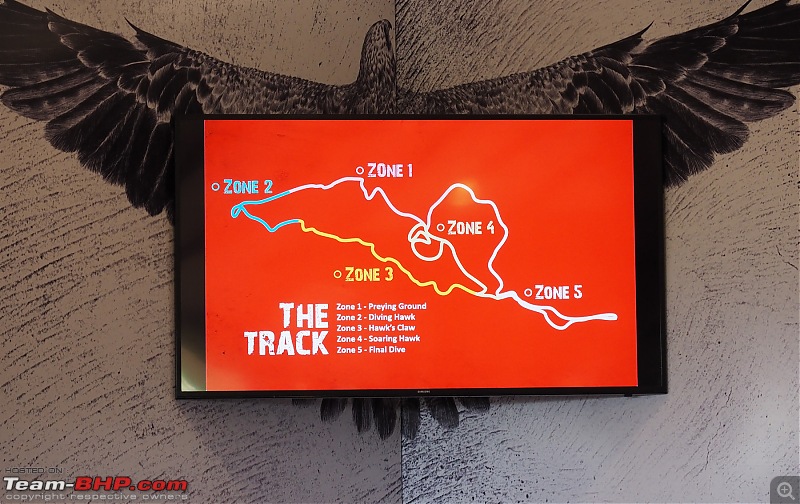 The trail started off with some man-made obstacles to show off the articulation of the Trailhawk. Actually, it doesnít have much articulation. What it really shows is how it can keep moving while having one, or even two wheels in the air:  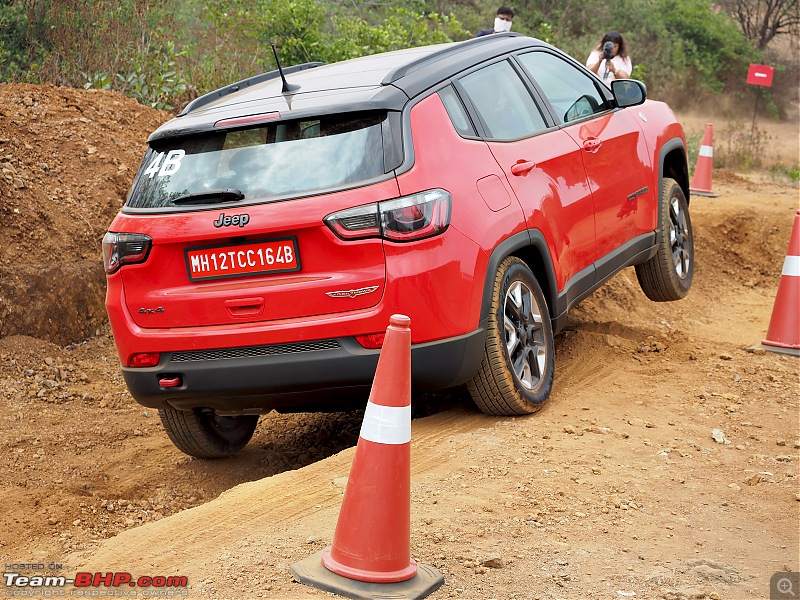    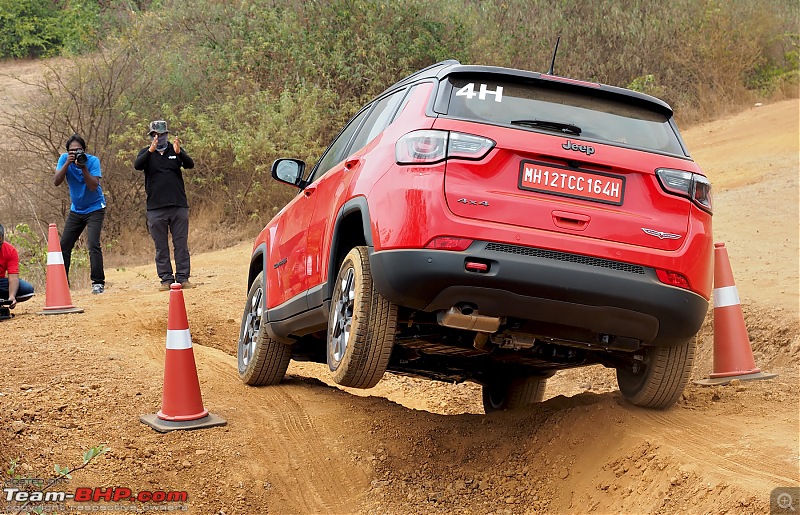 The next man-made obstacle demonstrated how the Trailhawk can drive at a 30-degree sideways angle:   Notice how the Trailhawk spins the tyre for half a second, stops, and slowly crawls out? That is because the slip was detected, brake was engaged, ensuring other tyres with traction continue to get torque. Do keep an eye out for this to repeat in the videos that follow: 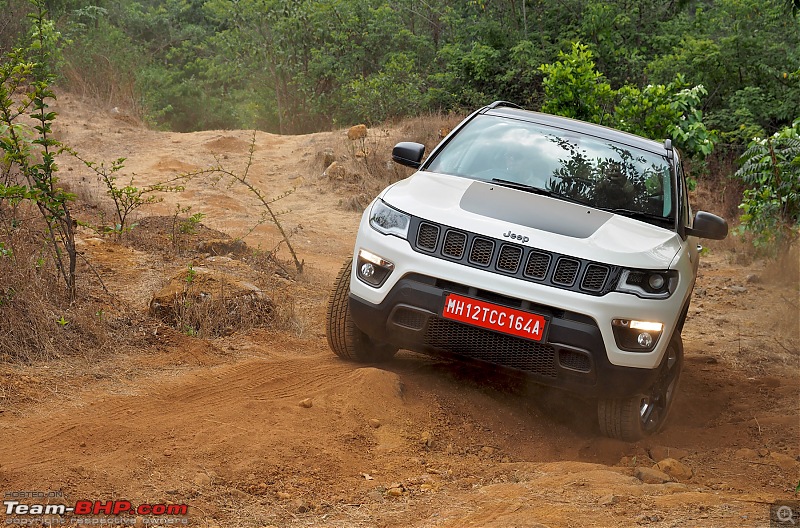  Last edited by Aditya : 22nd August 2019 at 12:39. |
| |  (35)
Thanks (35)
Thanks
 |
| The following 35 BHPians Thank Samurai for this useful post: | arun1100, arun_josie, blackwasp, carrot_eater, ChiragM, dailydriver, dhanushs, Dr.AD, DrANTO, Fuldagap, GTO, InControl, Jaggu, jithin23, Joxster, Keynote, megazoid, N33raj, paragsachania, RavenAvi, recshenoy, ruzbehxyz, samaspire, Samba, Sheel, shipnil, Simat, somspaple, suhaas307, The Rationalist, theexperthand, uday.ere, Varun_HexaGuy, vb-saan, VTec_KickedInYo |
| | #5 |
| Team-BHP Support  | The driving technique on a slippery trail is different in the Trailhawk. In a mechanical offroader, the driver takes the foot off the accelerator when any tyre starts spinning. But in the Trailhawk, we are supposed to slightly increase the throttle input, and the vehicle magically comes out. Well, it is not really magic. The trick has been explained in earlier posts. Here is another video where different tyres keep losing traction, but the Trailhawk keeps moving: There was not a lot of water in the water wading section of the trail:    Check out how the Trailhawk rides over rocks:  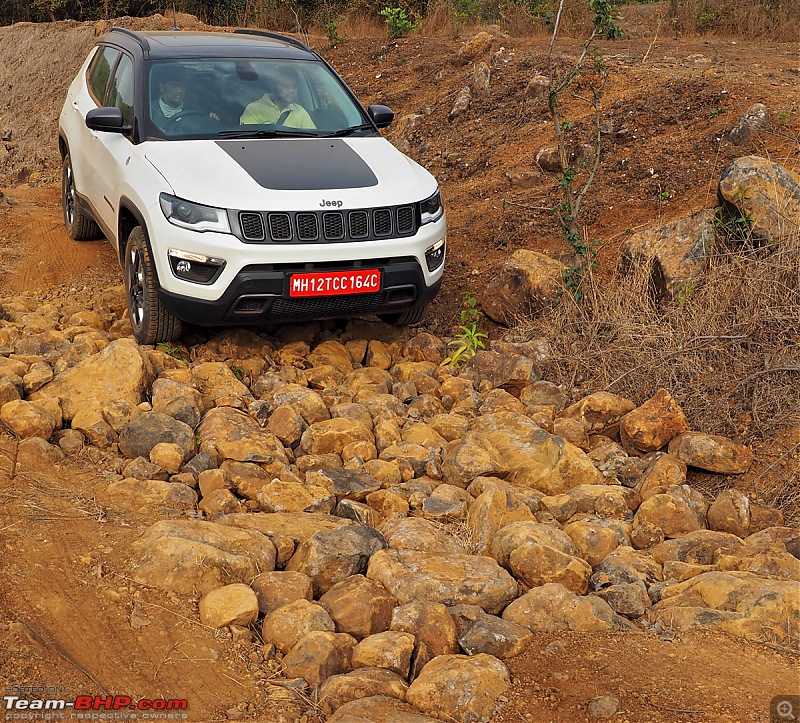 Here is another tricky turn and a climb up a slippery slope. A mechanical offroader requires momentum to climb this, but that can induce a rollover because of the sudden turn. That means a mechanical offroader has to take a different line of attack to avoid the turn and use the momentum. But, the Trailhawk can slowly tackle this while staying on the trail:    Notice how the Trailhawk tilts to the outer side of the turn and lifts the rear wheel. A mechanical offroader loses torque in the rear propeller in this case. It may reach that stage a little later due to better articulation. Since most of the weight is on the rear wheels, this obstacle requires a push from the rear wheels rather than a pull from the front wheels. Once the traction is lost, the vehicle has to reverse and consider a straighter approach with momentum. The Trailhawk will actually pause in this position and upon more throttle input, will use the push from the rear wheel with traction and finish the climb successfully:  Last edited by Aditya : 22nd August 2019 at 12:40. |
| |  (47)
Thanks (47)
Thanks
 |
| The following 47 BHPians Thank Samurai for this useful post: | 2himanshu, Arjun Reddy, arun_josie, binoyyj, BlackPearl, blackwasp, carrot_eater, chinmaypillay, ChiragM, cool_dube, dailydriver, Dr.AD, DrANTO, GTO, Hayek, InControl, Jaggu, jithin23, Joxster, Keynote, megazoid, msd7, N33raj, PapaBravo, PapaKiloSierra9, paragsachania, RavenAvi, recshenoy, rtdp, samaspire, Samba, Sheel, shipnil, Simat, somspaple, Sting, suhaas307, The Rationalist, theexperthand, Turbanator, uday.ere, Varun_HexaGuy, vb-saan, vredesbyrd, VTec_KickedInYo, warrioraks, Yeldo |
| | #6 |
| Team-BHP Support  | Another weakness of vehicles with a low crawl ratio is downhill driving. Even at maximum crawl ratio, the downhill speed would be too much. The Trailhawk tries to solve this problem by using Hill Descent Control (described earlier). But it can be dangerous in wet weather and braking while going downhill is considered a big no-no on slushy downhill roads. The tyres get locked, steering control is lost, and it is all up to luck. Wet trails have a lot less traction than dry trails. After looking at the Trailhawk sliding down the dry slippery trail, it is scary to think how it will handle the wet downhill slide, where the slide can be much faster. This is where drivers were asked to use Hill Descent Control. It doesnít activate until the vehicle tilts downward: In this video, there are two consecutive slopes. We were asked to use the brakes instead of Hill Descent Control. The driver had to be very careful in pressing and releasing the brakes to control the speed of the descent: The final long decline down a steep slope was very interesting. The following photo is quite misleading since it was shot from the top of the hill. It was a very steep hill, even walking down on foot would be quite difficult. Here we were asked to slide down using the brakes, keeping within the ruts to keep us straight:  The video shows how even on a dry trail, the Trailhawk kept sliding down with all wheels locked: This is one area where I suspect that the Trailhawk has a clear disadvantage compared to mechanical offroaders with much higher crawl ratios, which can come down without using brakes and without locking the wheels. They can also retain steering control all the way, unlike the Trailhawk. Having MT or AT tyres would have definitely helped here. Keep in mind that the Trailhawk did the entire trail on highway tyres. The much-improved approach, breakover, and departure angles really helped. When the bumpers did hit the surface, most of the impact was taken by the skid plates: 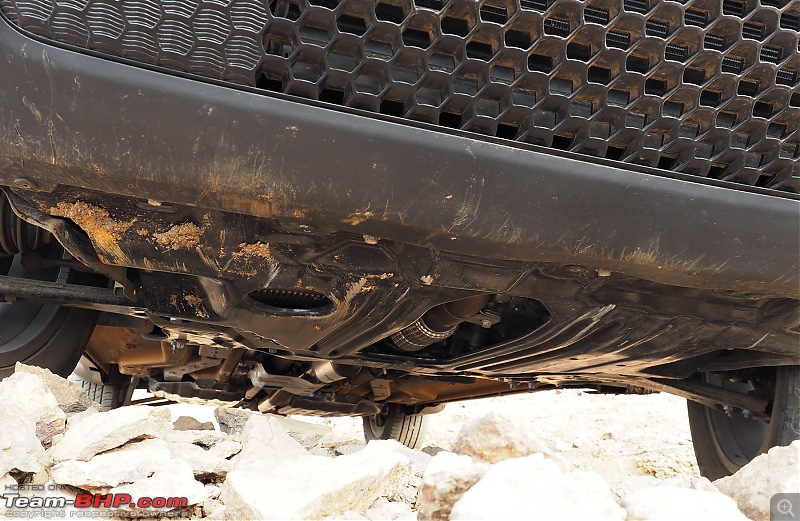 Having front and rear tow hooks are very important for any offroader. But the Trailhawk has a tow hook only in the rear. The front tow hook was removed because of the CMVR regulation about pedestrian safety. The rear hook is placed in an impractical way. The plastic cladding around the hooks appears to block any D-shackle, chain hook or towing eye from hooking onto the tow hook:  Next day we took the Trailhawk to the nearby Tungarli lake. The lake was mostly dry and we could just drive down until the water was found: 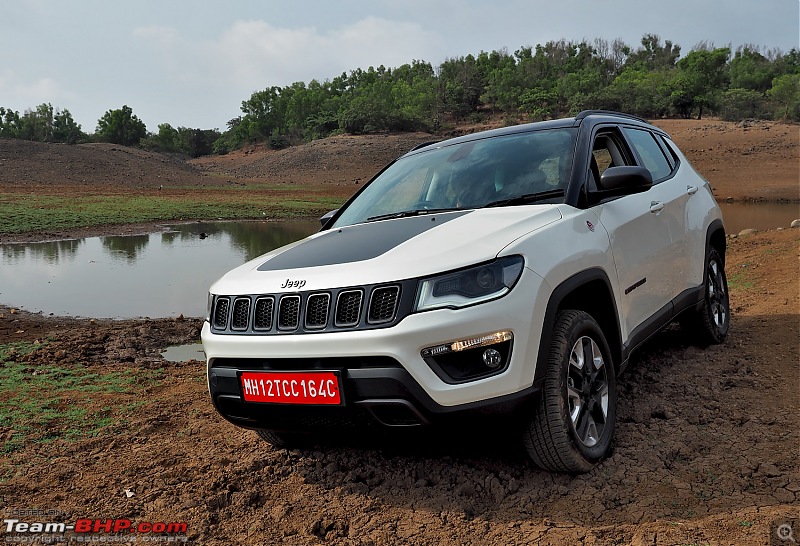    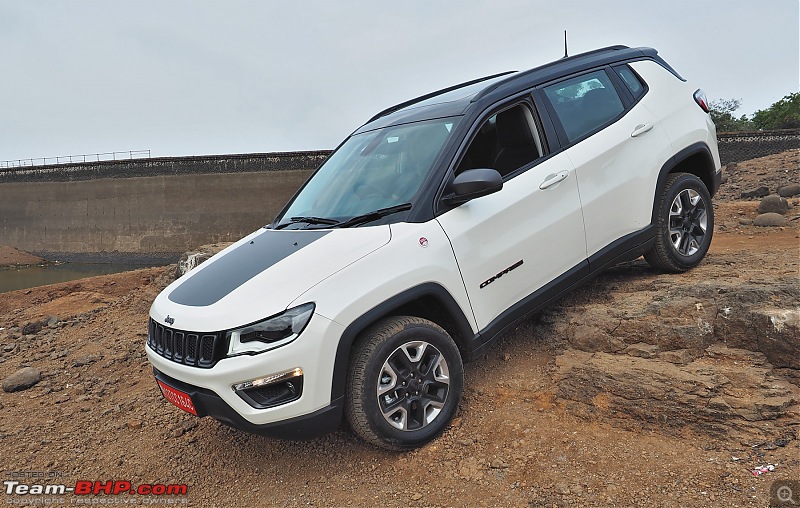  We could effortlessly drive up and down the lake bed like it was a playground. The surface was a lot more uneven than the Go-Pro wide-angle view indicates: Jeep India also provided some stock video footage from the same trail, which is pure eye candy: In conclusion, the Trailhawk is a very competent offroad vehicle in stock form. Downhill driving on a slippery trail is the only major weakness we could detect. Offroading is brutal on the brakes by design, since they need to constantly engage to retain torque. The suspension is very good, it soaked up the bumps very well in both offroad and on-road conditions. And here is the bad news. If you are a hobbyist offroader like me, you will find the Trailhawk extremely boring to drive in offroad conditions. For those of us who learnt offroading in mechanical offroaders, every obstacle is a puzzle to solve. We look at the obstacle, plan our approach, and then execute it. Success feels so good, and failure means retry with a new plan. That is what the offroading hobby is all about. But when you are driving a Trailhawk, you become a mere spectator while the Trailhawk does all the offroad puzzle solving. It feels like you are merely commuting on an offroad trail, rather than taking part in an automobile sport. This means you can go to difficult-to-reach places in comfort without losing any time. That is the USP of the Trailhawk. Disclaimer: Jeep invited Team-BHP for the Trailhawk test-drive. They covered all the travel expenses for this offroading event. Last edited by Aditya : 22nd August 2019 at 12:41. |
| |  (86)
Thanks (86)
Thanks
 |
| The following 86 BHPians Thank Samurai for this useful post: | 2himanshu, achyutaghosh, akhil_, AkMar, akshay81, anandpadhye, arbaz906, Arjun Reddy, arun_josie, BigBrad, bj96, BlackPearl, blackwasp, BoneCollector, carrot_eater, cbatrody, chinmaypillay, ChiragM, Contrapunto, cool_dube, deepakhon, Desmosedici, docprashant, Dr.AD, DrANTO, earthian, Full_Minchingu, gb97ce6, Gfactor, GoBlue, govigov, GTO, haisaikat, haldar_siliguri, Hayek, HR 16, InControl, Jaggu, Joxster, karan561, katoom, Keynote, mac187, mallumowgli, megazoid, mishraak, myavu, N33raj, PapaKiloSierra9, paragsachania, phamilyman, PM - B, psispace, puneetakhouri, raihan, ralto, RavenAvi, rtdp, RWD, samaspire, Samba, sanstorm, Sheel, shipnil, Shreyans_Jain, siddarthab, Simat, SJM1214, Skyline_GT, somspaple, SS-Traveller, suhaas307, supertinu, sups, The Rationalist, theexperthand, truezealous, Turbanator, TusharK, uday.ere, Varun_HexaGuy, vb-saan, vijay_rodie, vredesbyrd, vsrivatsa, warrioraks |
| | #7 |
| Team-BHP Support  | Re: Offroading with the Jeep Compass Trailhawk Thread moved from the Assembly Line to 4x4 Vehicles. Thanks for sharing! |
| |  (4)
Thanks (4)
Thanks
 |
| The following 4 BHPians Thank Aditya for this useful post: | blackwasp, GTO, Samurai, uday.ere |
| | #8 |
| Distinguished - BHPian  | Re: Offroading with the Jeep Compass Trailhawk Thanks Samurai for this technical review. I genuinely wanted to buy the TRAILHAWK, but somehow the constant delays made me lose interest & also the pricing is not inviting. Also the Ground clearance which is now 30mm more than standard hence making it 208 mm is still lower than international spec which i believe is 215 mm ? |
| |  (4)
Thanks (4)
Thanks
 |
| The following 4 BHPians Thank karan561 for this useful post: | RavenAvi, Samurai, The Rationalist, uday.ere |
| | #9 |
| Senior - BHPian Join Date: May 2012 Location: BLR/PTR
Posts: 3,278
Thanked: 9,646 Times
| Re: Offroading with the Jeep Compass Trailhawk Nice review Samurai. Price aside, this car to me has great potential, Compact size, decent 4x4 kit is something missing in the market. People who don't wan't a dedicated offroad vehicle like Thar and want just one car which can be your office ride for weekday and off roader for weekend, this is it. At 35L on road in Bangalore, this is almost in Fortuner/Endeavour territory and one should probably wait for couple more months for discounts to pour in. |
| |  (3)
Thanks (3)
Thanks
 |
| The following 3 BHPians Thank PrideRed for this useful post: | Dr.AD, sainyamk95, Samurai |
| | #10 |
| Senior - BHPian Join Date: May 2019 Location: Kozhikode
Posts: 1,226
Thanked: 5,499 Times
| Re: Offroading with the Jeep Compass Trailhawk Great review and explanation of all the techniques involved. I guess off roading will go more and more in this direction with machine doing most of the creative work. And I like that . So people like me who has no experience in offroading also can just buy a 4x4 with all these electronics and go explore places. One question, though ,Wouldn't any two wheel drive vehicle with ESP and individual brake control act like an differential locked two wheel drive mechanical off roader ? Trailhawk's different modes are anyway just different ESP maps. Which means some of the front wheel drive pseudo SUVs with ESP would be as good as a two wheel drive differential locked mechanical offroader. Add to that they can use the steering on the driven wheels as well which rear wheel drive mechanical offroaders can not. Last edited by padmrajravi : 22nd August 2019 at 14:10. |
| |  (5)
Thanks (5)
Thanks
 |
| The following 5 BHPians Thank padmrajravi for this useful post: | bj96, mallumowgli, megazoid, sainyamk95, Samurai |
| | #11 |
| BHPian Join Date: Sep 2018 Location: Pune
Posts: 314
Thanked: 989 Times
| Re: Offroading with the Jeep Compass Trailhawk Excellent review & technical analysis. Quite an interesting read. I think what Jeep has tried to make is a very competent machine that can tackle 99% off road demands of its owners. Hobbyist off roaders as it is will prefer customising their own machines for their events. So I don't think the Trailhawk is targeted at them. It is for those well heeled who are adventurous however prefer comfort & convenience primarily. |
| |  (1)
Thanks (1)
Thanks
 |
| The following BHPian Thanks superbad for this useful post: | Samurai |
| |
| | #12 |
| BHPian | Re: Offroading with the Jeep Compass Trailhawk The explanations are really good, a great review by team-bhp. The photos are awesome. Finished in one go, a big thumbs up. My question: is it more boring to drive on road than the regular Compass which is quite nice and mature? Last edited by 2himanshu : 22nd August 2019 at 14:44. Reason: Corrected spelling |
| |  (1)
Thanks (1)
Thanks
 |
| The following BHPian Thanks 2himanshu for this useful post: | Samurai |
| | #13 |
| BHPian Join Date: Jul 2013 Location: Chennai
Posts: 236
Thanked: 347 Times
| Re: Offroading with the Jeep Compass Trailhawk I think this is a good vehicle which offers offroad thrills for common folks who enjoy driving in general and not for offroad enthusiasts/purists. OT: I see a white Renegade in the top left corner in one of the pictures. Was it trailhawk as well? Any info on that model? |
| |  (1)
Thanks (1)
Thanks
 |
| The following BHPian Thanks katchkamalesh for this useful post: | Samurai |
| | #14 |
| Team-BHP Support  Join Date: May 2004 Location: Bangalore
Posts: 20,212
Thanked: 15,891 Times
| Re: Offroading with the Jeep Compass Trailhawk Ah finally the Compass TrailHawk edition is out! Ages since we did the original review, and at that time they mentioned it would be coming a lil later. I feel it is too late now! This vehicle should have been launched within 6 months of the original launch, it already had a limited market which has further slipped to lesser numbers... with this delayed launch. Thanks for covering the details Samurai and Blackwasp. Was interesting to read, especially how the electronics kicks in. Having done lil bit of Offroad in my automatic Grand Vitara (and to some extend the Endy) I can confidently say, full brakes and no brakes are both wrong approach to use in an auto tranny and ECU controlled engine while going steep downhill. During the Apollo drive we had opportunity to try out some old RFC trails with the GV, and idea is to have a balance of throttle and brakes. Full lock meant it would just slide based on the inclination (which can be disastrous during wet) and no brakes caused vehicle to run off even in Low mode. A mix of both is what is needed. I think here the event guys were demonstrating the how vehicle would perform using hill decent and then using brakes? ECU idle compensation is another issue, even with stock Thars under situations which need tight controlled approach, the idle compensation kicking in needs a bit of getting used to. Hopefully Compass has this factored in Trail Hawk. Last edited by Jaggu : 22nd August 2019 at 15:05. |
| |  (10)
Thanks (10)
Thanks
 |
| The following 10 BHPians Thank Jaggu for this useful post: | 4x4addict, DrANTO, mallumowgli, quickdraw, RavenAvi, samaspire, Samurai, suhaas307, Turbanator, uday.ere |
| | #15 | ||||
| Team-BHP Support  | Re: Offroading with the Jeep Compass Trailhawk Quote:
Quote:
Quote:
 Quote:
This was our support vehicle:  Last edited by Aditya : 26th August 2019 at 08:09. Reason: Typo | ||||
| |  (12)
Thanks (12)
Thanks
 |
| The following 12 BHPians Thank Samurai for this useful post: | 2himanshu, CrAzY dRiVeR, Dr.AD, DrANTO, InControl, megazoid, quickdraw, RavenAvi, samaspire, The Rationalist, Turbanator, uday.ere |
 |


